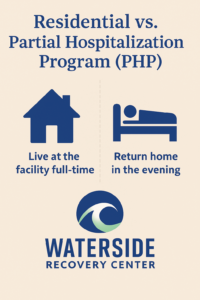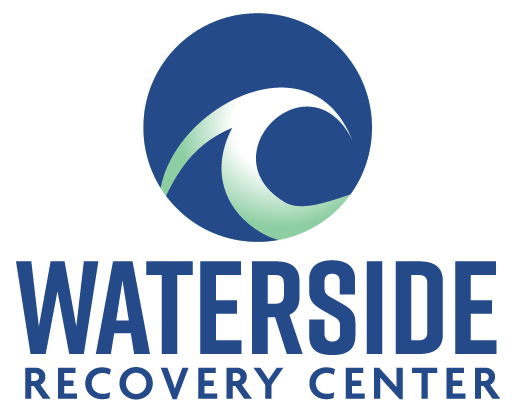You’ve hit that moment—the one where something inside says, “Okay, it’s time.” You’re not doing great. You’re tired of trying to outrun whatever this is. Maybe it’s drinking more than you planned. Maybe it’s panic attacks, crashing moods, or feeling like you’re unraveling inside.
You know you need help. But you don’t know what kind.
That’s where this guide comes in.
Let’s break down the difference between Residential Treatment and a Partial Hospitalization Program (PHP)—so you can figure out what’s right for where you are, right now.
1. What Is Residential Treatment?
Residential treatment—sometimes called inpatient rehab—means you live at the facility full time for a set period, usually 30 to 90 days. It’s immersive, structured, and provides 24/7 support.
Residential treatment includes:
- A fully structured daily schedule
- Supervised detox if needed
- Group therapy, individual therapy, and family therapy
- Medication management
- 24/7 monitoring and crisis support
It’s often the best option if:
- You’re dealing with serious or life-threatening addiction
- Your home environment isn’t safe or stable
- You’ve tried outpatient care and relapsed
- You need space away from daily triggers and responsibilities
Residential gives you a protective reset. You focus 100% on healing without distractions like work, phones, or outside obligations.
2. What Is a Partial Hospitalization Program (PHP)?
A Partial Hospitalization Program (PHP)—also called day treatment—is a step down in intensity from residential care. You get structured, intensive treatment during the day, and return home (or to a sober living) in the evening.
At Waterside Recovery, our partial hospitalization program in Massachusetts includes:
- 5 days per week of programming (about 5-6 hours per day)
- Daily therapy (group and individual)
- Psychiatric support and medication management
- Trauma-informed and dual-diagnosis care
- Evidence-based curriculum with relapse prevention, emotional regulation, and life skills
PHP is a great fit if:
- You’re struggling, but medically and emotionally stable
- You need more than weekly therapy but can manage evenings independently
- You want to integrate recovery tools into your daily life
- You’re stepping down from residential care and want continued structure
PHP gives you intensity and accountability—without full-time separation from your life.
3. PHP vs. Residential: What’s the Real Difference?
The biggest difference? Where you live during treatment.
- Residential = you stay at the facility full-time
- PHP = you go home (or to supportive housing) after daily sessions
Other differences include:
Structure:
- Residential is more rigid with daily routines.
- PHP allows more freedom and real-world practice.
Cost:
- Residential tends to be more expensive due to housing and 24/7 staffing.
- PHP is often more cost-effective and may be better covered by insurance.
Support Needs:
- Residential is better for crisis stabilization.
- PHP is ideal for early intervention or ongoing support after crisis.
Ultimately, it’s about what level of care will set you up to succeed—not just today, but in the long run.

4. How to Choose the Right Path
This decision can feel overwhelming. But it gets easier when you focus on your needs, not someone else’s timeline.
Here’s a quick way to reflect:
Ask yourself:
- Am I in immediate danger physically or emotionally?
- Can I stay substance-free overnight on my own?
- Do I have a safe, supportive home—or will it pull me back into old patterns?
- What kind of structure actually helps me stay accountable?
If you answered:
- Yes to crisis, risk, or unsafe home → consider residential
- No to those, but still struggling → PHP might be your fit
You can also call Waterside Recovery for a clinical assessment. We’ll help guide you—no pressure, no hard sell. Just clarity.
Getting help doesn’t mean you’ve failed. It means you’re brave enough to try something better.
5. Real Talk: What I Wish I Knew
I chose PHP. Not because things weren’t serious—but because I needed to know if I could show up for myself while still showing up for my life. I was scared, unsure if I “deserved” help, worried I’d be judged.
But here’s what happened:
- I felt seen without being shamed
- I learned real tools I could use at night, not just in session
- I didn’t have to walk away from everything—I just had to walk into something healthier
And most importantly? I realized I didn’t have to hit rock bottom to ask for help.
Whether you choose PHP or residential, that first step matters more than anything. Don’t let confusion stop you from beginning.
Frequently Asked Questions (FAQs)
Q: Is PHP covered by insurance?
Yes, many insurance plans cover PHP. Waterside Recovery will verify your benefits and walk you through any out-of-pocket costs upfront.
Q: What if I start PHP and realize I need more help?
That’s okay. We can help you transition into residential care or coordinate higher levels of support as needed.
Q: Can I work while attending PHP?
Possibly, depending on your schedule. Many clients take temporary leave or adjust hours. We can help you plan around work obligations.
Q: Is residential more effective than PHP?
Not necessarily. The best outcomes come from matching treatment to your needs and readiness—not from one-size-fits-all intensity.
Q: What’s the first step to get started?
Call us. We’ll schedule a confidential consultation and help you determine the right level of care—without judgment.
Let’s Talk Through Your Options
Call (866) 671-8620 or Contact Us. Whether you choose residential treatment or a partial hospitalization program, what matters most is that you choose something.


